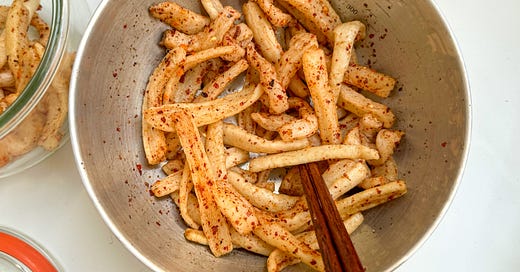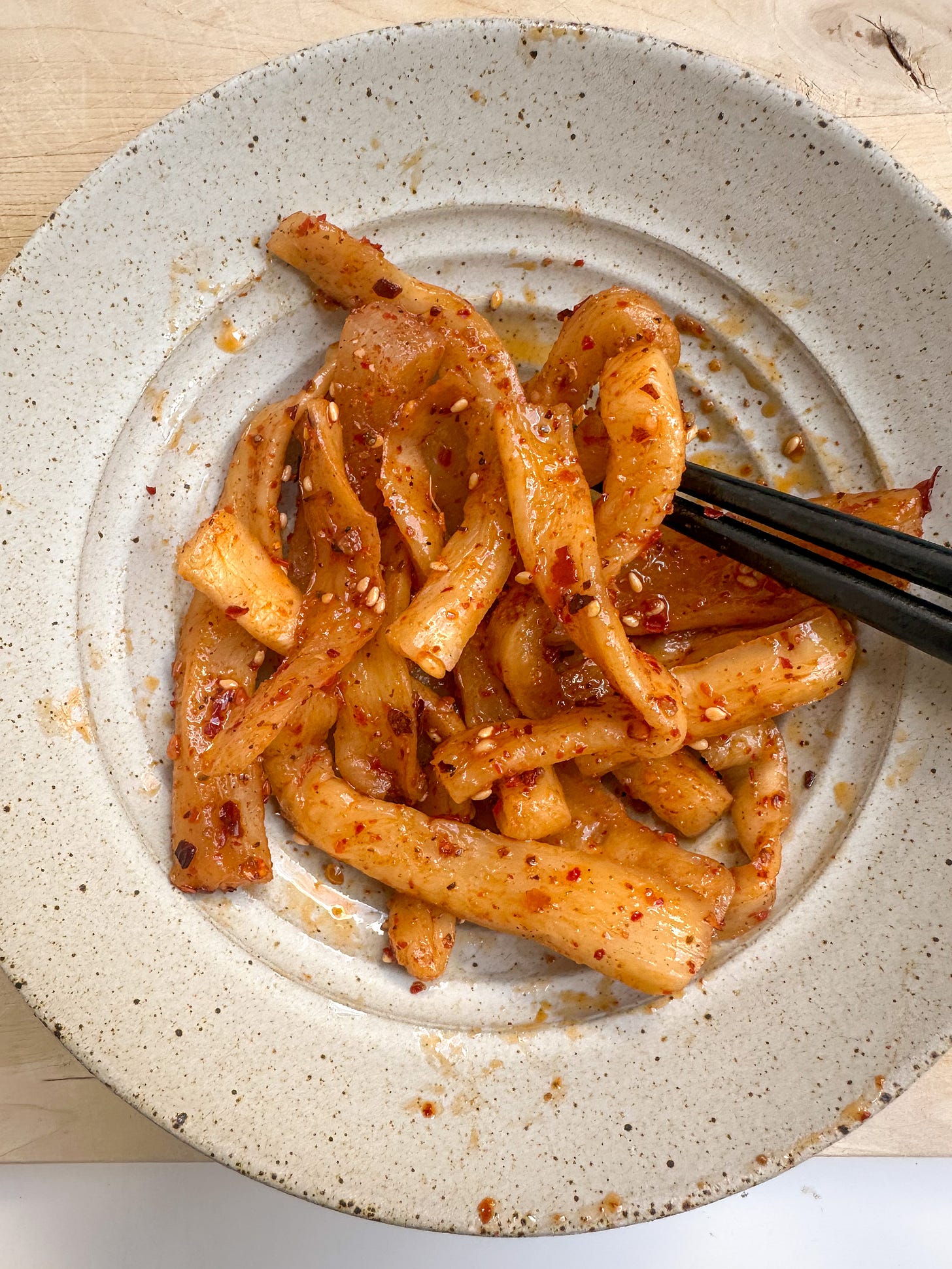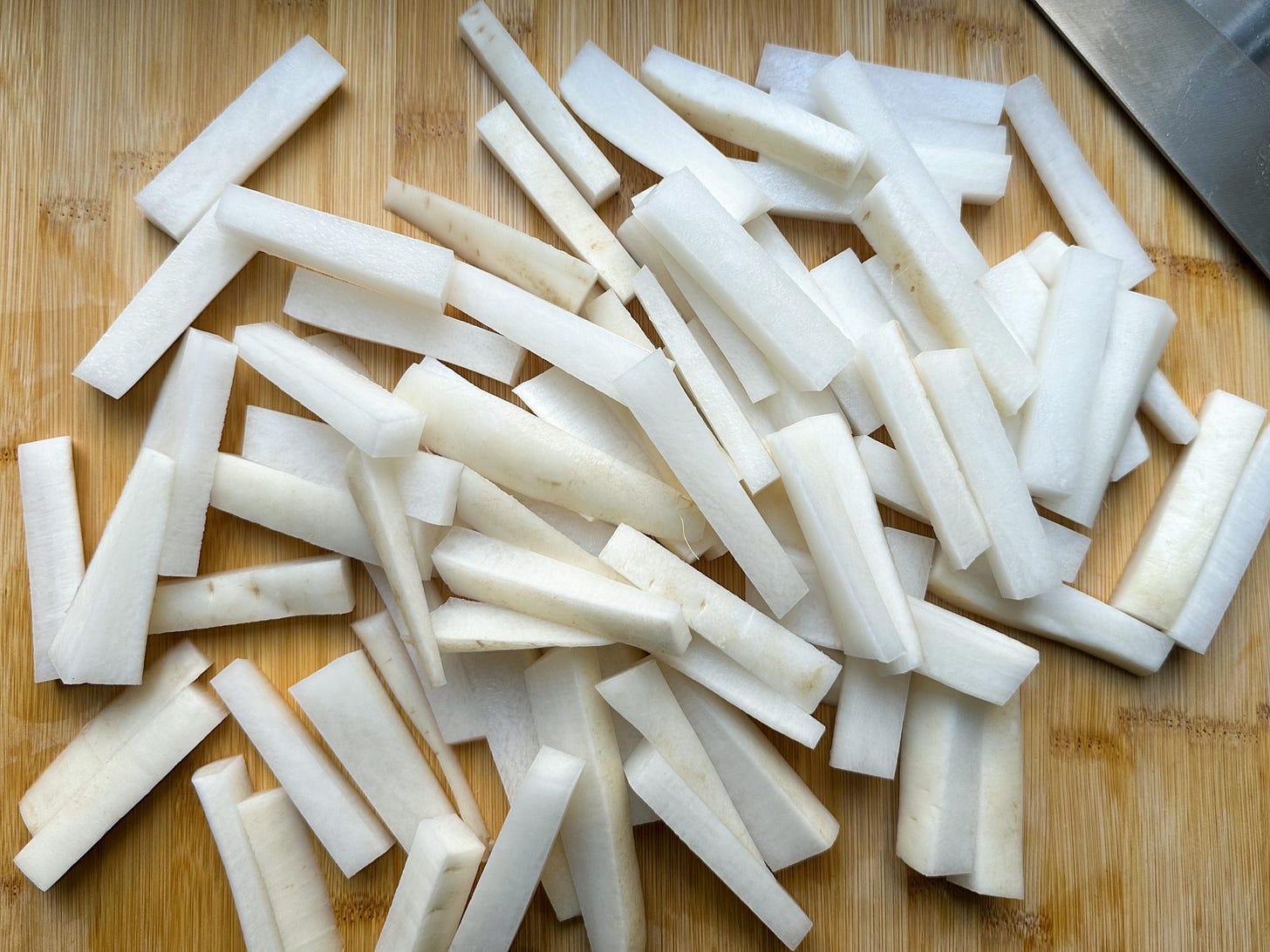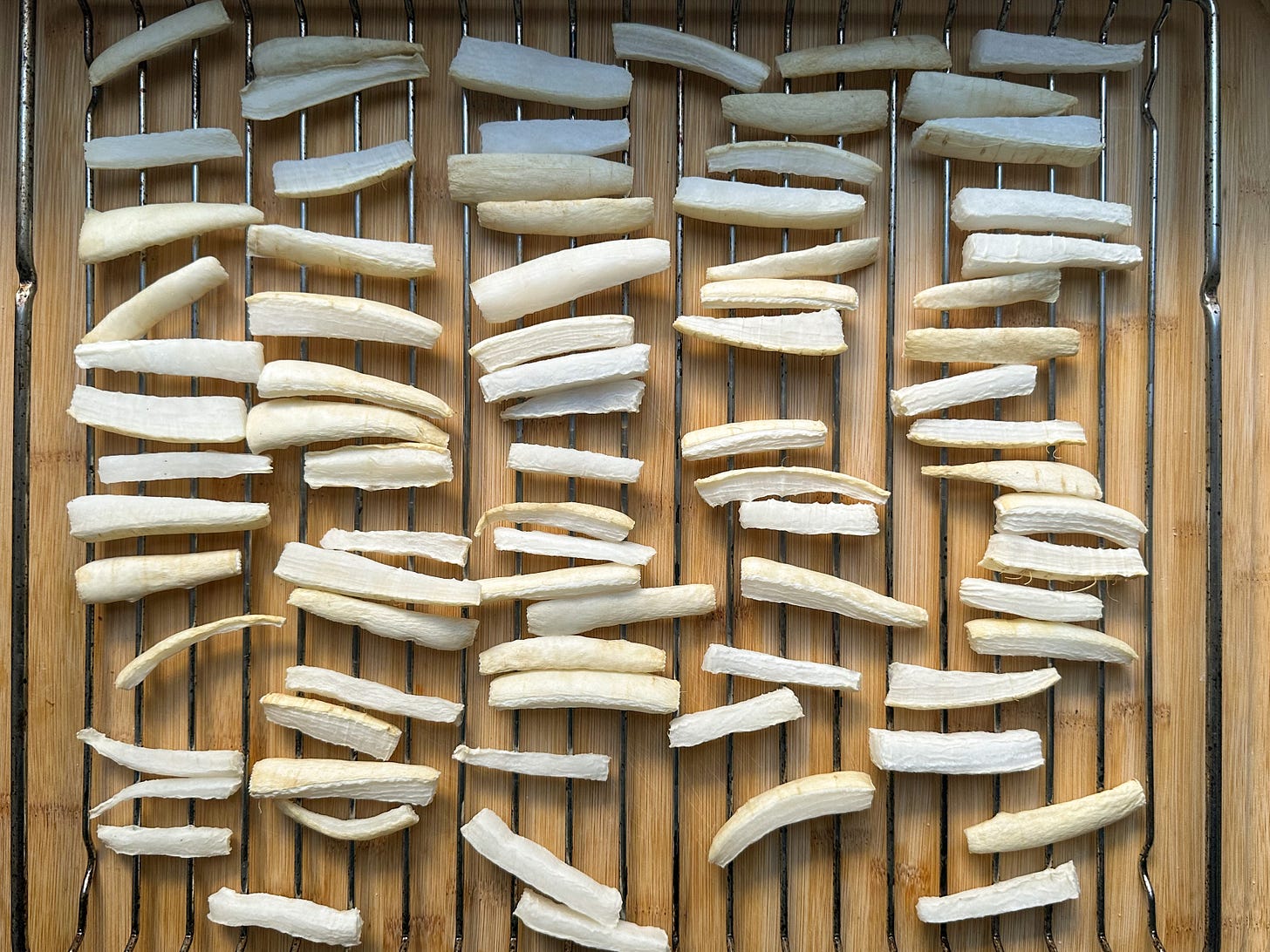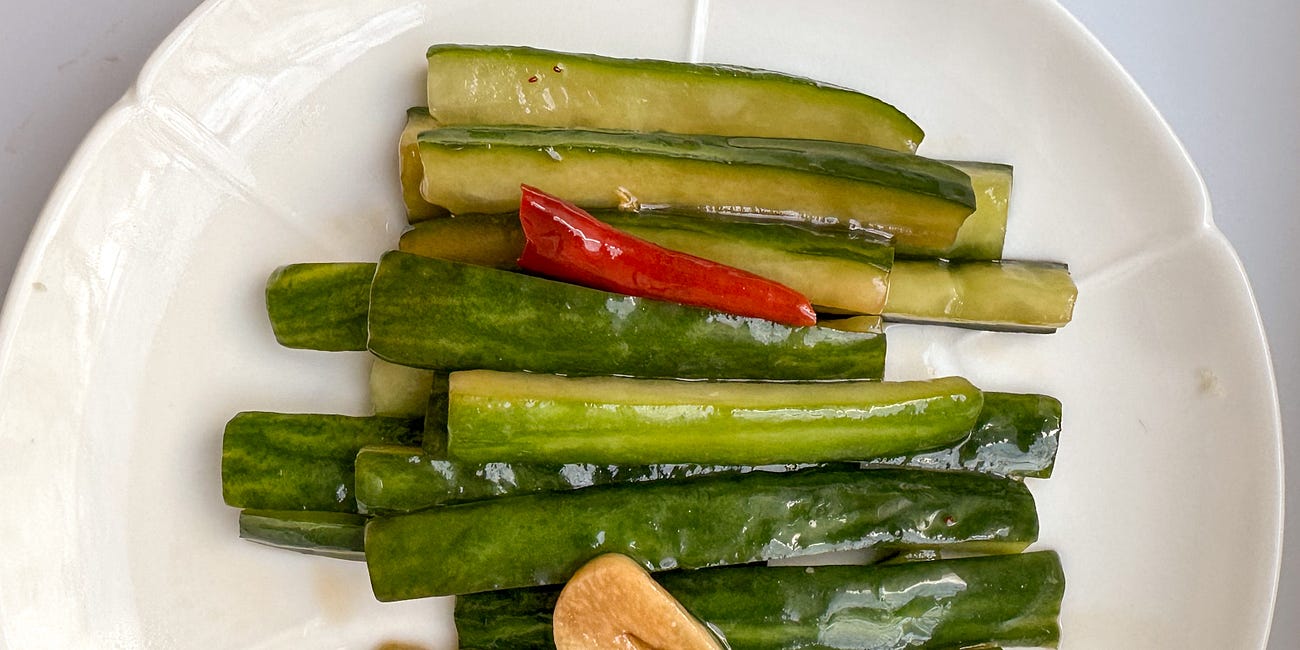For months now, I’ve been obsessed with a bag of mala-flavored preserved daikon. I bring it out to serve with rice or congee, but somehow, I keep snacking on it long after the meal. It’s crunchy, flavorful, and perfectly balanced between spicy and sweet.
Then I thought about how my family had been making it for decades—how my grandparents used to hang radishes in their rooftop garden, where they dangled like a row of octopuses. In Sichuan, people are passionate about preserving and pickling vegetables. There are normally two types: lacto-fermented pickles, paocai (泡菜), or salt-preserved vegetables, known as yan cai(腌菜) or xian cai (咸菜). You’ll often see daikon radishes and mustard greens sun-drying on the roadside, completely unattended. Almost every farmer’s market has a stall that sells an array of ready-to-eat preserved vegetables. Some of the most famous varieties, like Yacai (used in dandan noodles) and Zhacai (used in hot and sour noodles), are now mass-produced. But many families, including mine, still make their own.
The most common ingredients for preserved vegetables are mustard greens, mustard tuber (stem mustard), radishes (red, green, and white), turnips, and carrots. Since I have good access to daikon radish, we’re making Luobogan (萝卜干), a preserved daikon, which has countless regional variations across China. In Cantonese cuisine, you’ll also find a sweeter version known as cai pu / chai poh (菜脯). During a recent WeChat video call, my grandma proudly showed me two versions: A seasoned, ready-to-eat preserved mustard tuber. An extremely dried, unseasoned daikon that needs to be rehydrated for stews (often stewed with Chinese cured meat).
Like eating chives or other pungent herbs, ancient Chinese believed radishes helped combat spring fatigue and revitalized the body. That said, I’m not chewing on daikon to replace my morning coffee—I make this recipe purely for the satisfying texture.
This is a nice little project if you’re looking to try something new. It requires minimal effort beyond waiting, and you have access to fresh, affordable daikon. For me, it’s more about the fun of making it than about saving money, as a jar of luobogan costs only about 3-4 euros at my local Asian grocery store (the cost of making it myself is about the same, if not higher).
Making Crunchy Preserved Daikon Radish
According to my grandma and great-aunt—who have been making preserved vegetables for decades—the process is simple: 1. Slice the vegetables; 2. Optionally salt it; 3. Sun- or wind-dry it for a few days until dehydrated; 4. Season with spices and store in the fridge. Industrial versions go through additional drying and salting steps to preserve them for longer.
1. Keep the Skin On!
When buying fresh daikon, look for smooth, pale white skin without bruises. DON’T peel it! The skin is crunchier than the flesh.
2. Dehydration Process
Salt Ratio:
Use 3–4% of the radish’s weight in salt. Industrial luobogan often contains 7–10% salt, but my first batch at 7% was too salty. I found that 3-4% works better, depending on whether you want a snackable or saltier version (used for cooking)1. After salting, squeeze out as much water as possible.
Drying Methods:
I prefer the radish to be dry enough to be chewy but not too tough. Depending on your kitchen and home setup, here are three ways to dry the radish:
Indoor drying: Salt the daikon, drain it over a sieve or on a paper towel-lined baking sheet, and let it dry overnight or for 1 day, replacing the paper towel as needed. This method retains more moisture but is the easiest. It’s best to serve it in the next few days.
Sun & wind drying: If you have a balcony or yard, place the daikon on a baking rack or bamboo tray. Let it dry for 2–4 days in sunny, dry weather, and take it back indoors at night. However, be cautious—warm temperature and humidity can cause spoilage. I lost a batch in Berlin’s damp air when it turned slimy. When they’re properly dehydrated, rinse off any dust and dry them again to remove excess moisture.

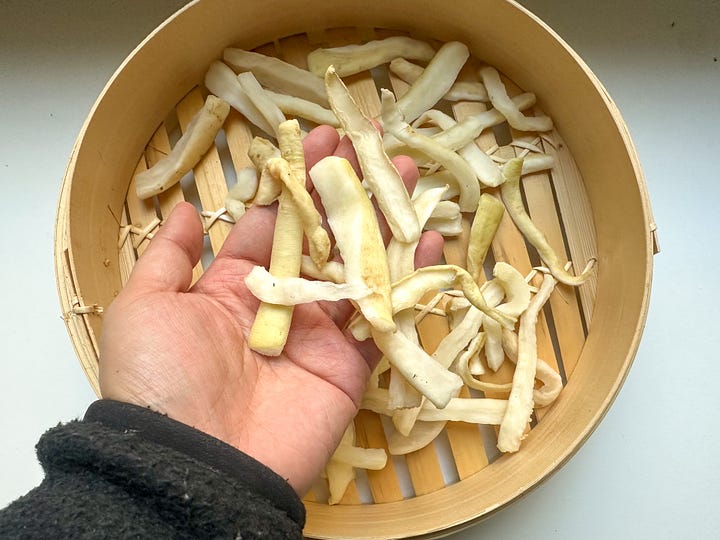
Oven or dehydrator drying: A food dehydrator works well. I use an oven at 80°C-90°C (175ºF -195ºF) for 1.5–2 hours and check at the 1-hour mark to see the dryness. Then, let it air-dry for a few more hours or overnight. This method is quicker, though your kitchen will smell of raw radish.
3. Season
My grandma prefers using dry spices only, including sugar, salt, ground Sichuan pepper, five-spice powder, chili flakes, and MSG. It keeps for a few weeks in the fridge—or, in her words, “a long time.” She dresses them with chili oil and soy sauce before serving. If you’re serving them very soon, you can directly season them with chili oil, soy sauce, and sesame oil, plus the spices. For extra flavors, you can also use seasoned chili flakes (dipping chili) from Asian grocery stores, like brands like cui hong (翠宏) or liu po (六婆).
This technique isn’t limited to daikon—you can use it with other radishes, carrots, or kohlrabi. For carrot and kohrabi, which has less water content than daikon radish, reduce the drying time in the oven.
Enjoy it with steamed rice, congee, and savory oats, or chop them into smaller pieces and use them in scrambled eggs, omelets, fried rice, and noodles hot and sour noodles, minced meat noodles) to add texture and flavor.
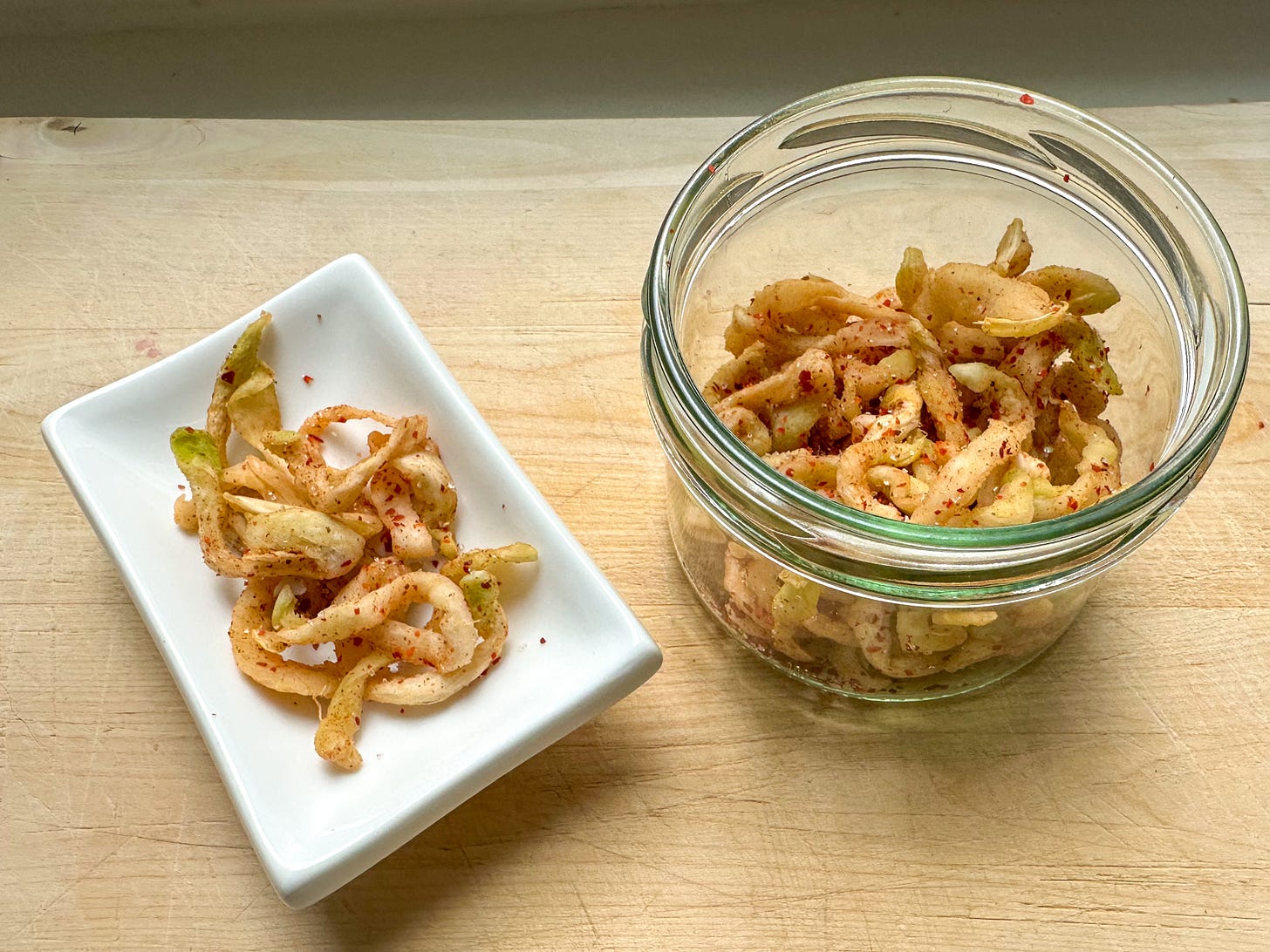
Recipe: Crunchy Mala Preserved Daikon Radish(麻辣萝卜干)
makes a small jar of luobogan, feel free to double the ingredients
Ingredients
2 lb (900g) daikon radish
2-3 tbsp kosher salt (approx. 30g)
900g of fresh radish reduces to 210–240g after drying.
Seasoning for 210g (7 oz.) Dehydrated Radish:
1 tsp white sugar
1–2 tsp chili flakes, preferably from Sichuan
¼ tsp five-spice powder
¼ tsp ground Sichuan pepper
kosher salt to taste
⅛ tsp MSG (optional)
For serving: sesame oil, chili oil, black vinegar
Instructions
Wash and scrub off any dirt off the daikon radish. Remove bruises and small root hairs, but keep the skin on for extra crunch. Cut into finger-sized pieces (like chunky French fries).
In a big bowl, toss the radish with salt and let it sit for 2 hours (optional: press it with a heavy object). Drain and squeeze out excess moisture with a clean cloth.
Place a single layer on a rattan tray or baking rack. Let it dry outdoors, in dry and sunny weather, for 2-3 days (preferably in sunlight) until it reaches the desired texture. Or use the oven alternative (see above).
If the radish is dried outside, clean it with hot water and let the moisture on the surface dry off. Toss with chili flakes, sugar, five-spice, MSG, and salt to taste. Rub the seasoning in so it sticks to the daikon. Give it a taste and add more seasoning if needed. Pack tightly into an airtight jar. Store in the fridge for up to 2 weeks.
When serving, dress with sesame oil, chili oil, and toasted sesame seeds if liking.
If you’re looking for a quicker vegetable pickle, try these soy-vinegar pickles with daikon radish and cucumber:
Quick Soy-Vinegar Cucumber and Daikon Pickles
·Hi! We talked about black vinegar in depth last week, and here’s something approachable and a perfect gateway to incorporating more Chinese vinegar into your cooking repertoire: quick soy-vinegar vegetable pickles.
The book about Japanese vegetable preserving, Tusukemono explains that the introduction of refrigeration has extended the life of preserves and has reduced the salt level to 3-4%.

